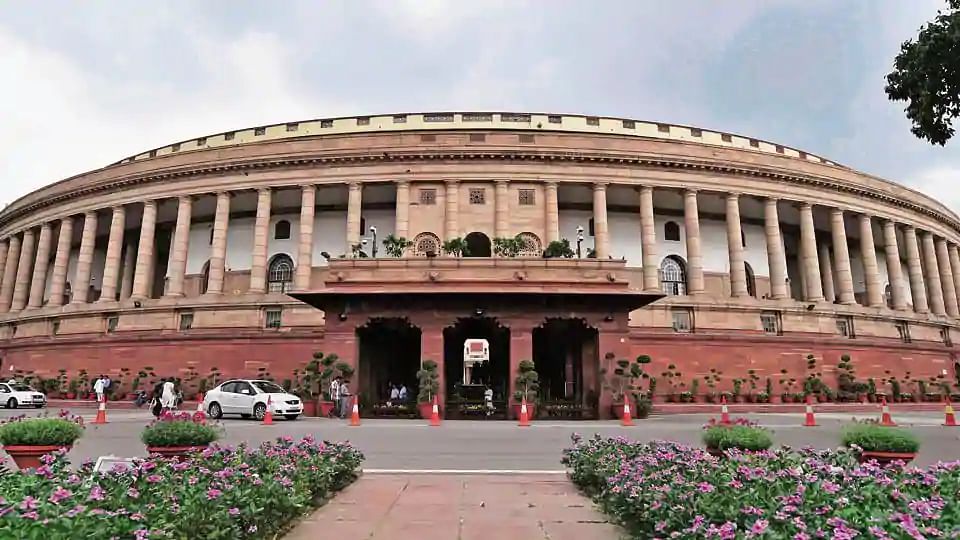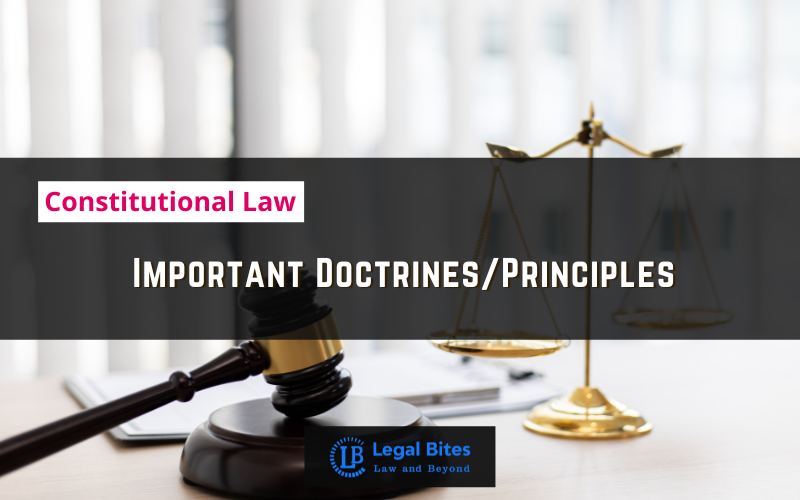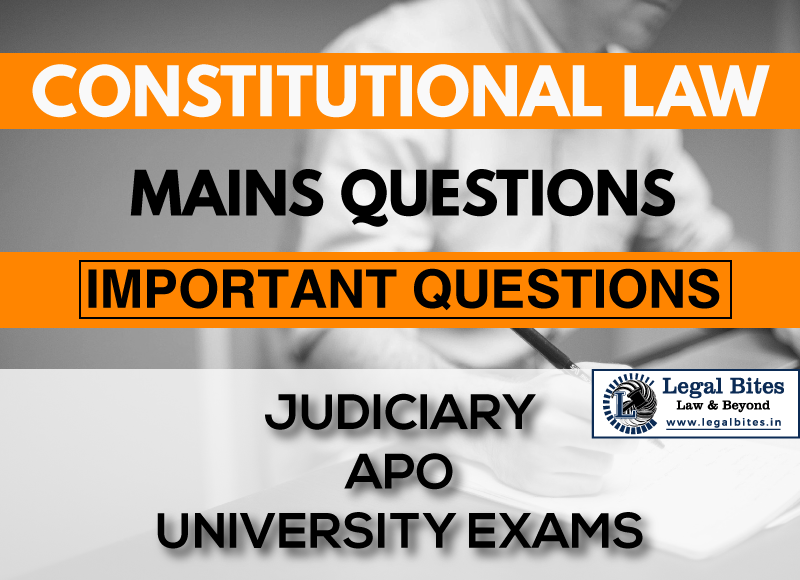Indian Parliament: Composition, Functions, Privileges & Inter-relation
This article discusses the different components that constitute the Parliament of India which comprises of the President and both the Houses, namely the Lok Sabha and the Rajya Sabha. It also analyses the composition, powers and functions, the relationship between both the Houses, privileges and limitations of these bodies constituting the Parliament. “Each House has full authority to… Read More »
;
This article discusses the different components that constitute the Parliament of India which comprises of the President and both the Houses, namely the Lok Sabha and the Rajya Sabha. It also analyses the composition, powers and functions, the relationship between both the Houses, privileges and limitations of these bodies constituting the Parliament. “Each House has full authority to regulate its own procedure within the limits of the Constitution. Neither House, by itself,...
This article discusses the different components that constitute the Parliament of India which comprises of the President and both the Houses, namely the Lok Sabha and the Rajya Sabha. It also analyses the composition, powers and functions, the relationship between both the Houses, privileges and limitations of these bodies constituting the Parliament.
“Each House has full authority to regulate its own procedure within the limits of the Constitution. Neither House, by itself, constitutes Parliament. It is the two Houses together that are the Parliament of India. The successful working of our Constitution, as of any democratic structure, demands the closest cooperation between the two Houses.”[1] – Pandit Jawaharlal Nehru, First Prime Minister of India
Introduction
The Parliament has three significant functions- to formulate laws, to become a forum to debate on the various issues relating governance for safeguarding the rights of the citizens and to impose accountability of the executive. The Constitution of India clearly puts forth the foundation for a functioning democracy. [2]
India has embraced a parliamentary form of system which showcases and represents the diversity present in India; in addition to this, the Parliament addresses the occurrence of various challenges. In the last few decades of incorporating the parliamentary system, India has made remarkable progress towards different areas, at both national and international levels.
According to the Constitutional schemes, the Parliament of India comprises of the President, and the two houses of the Parliament known as Council of States or Rajya Sabha and House of the People or Lok Sabha. Both the houses enjoy similar powers under the Constitution of India, except in financial matter where the Lok Sabha has superiority over the Rajya Sabha. Similarly, the Upper House or the Rajya Sabha has been vested with certain special powers which Lok Sabha does not enjoy. [3]
I. Composition of the Parliament
1. The President of India
The Central Executive constitutes the President, Council of Ministers headed by the Prime Minister. President is the nominal head of the State[4]. Every executive action in the central level is conveyed in his authority. The power has been vested to him under Article 53 (1) of the Constitution of India which conditions that the executive power would be vested in the President and shall be implemented by him in a direct or indirect manner through his officer’s subordinate.
The conditions relating to the office of the President are[5]
- The President shall not be a member of either House of Parliament or of a House of the Legislature of any State, and if a member of either House of Parliament or of a House of the Legislature of any State be elected President, he shall be deemed to have vacated his seat in that House on the date on which he enters upon his office as President.
- The President shall not hold any other office of profit.
- The President shall be entitled without payment of rent to the use of his official residences and shall be also entitled to such emoluments, allowances and privileges as may be determined by Parliament by law and, until provision in that behalf is so made, such emoluments, allowances and privileges as are specified in the Second Schedule.
- The emoluments and allowances of the President shall not be diminished during his term of office.
2. Rajya Sabha or Council of States
Composition and Membership
The Council of States or the Rajya Sabha is the Upper House of the Parliament, consisting of more than 250 members at present, encompassing 238 Members representing the States and Union Territories[6] and 12 members who are nominated by the President who possess special knowledge and practical experiences in relation to literature, art, science and social service.[7]
At present, there are 245 members in the Rajya Sabha. Where 233 members are representatives of the States and Union territories and 12 are nominated by the President.[8] The Rajya Sabha is considered as a permanent body is not subjected to dissolution. However, one- third of its members retire biennially, after the completion of a term of six years.
The elections held to fill in the vacancy which arises if not by the retirement of a member on the expiration of his/her term of office is called ‘Bye-election’.[9]
Powers and Functions
- Legislative Powers
The Rajya Sabha enjoys the similar power of the Lok Sabha, in terms of ordinary law making. An ordinary bill initiated in the Rajya Sabha cannot become a law unless passed by it. In case there is a deadlock between both the Houses in relation to an ordinary bill and is unresolved for six months, the President can summon a joint sitting of both the Houses to resolve the deadlock. The Joint sitting is headed by the Speaker of the Lok Sabha. If the bill is passed in the joint sitting, it gets sent to the President for his signature. In case the deadlock remains unresolved the bill will be quashed.
- Financial Powers
A money bill cannot be initiated in the Rajya Sabha; it can be introduced only in the Lok Sabha.[10] However, this money bill is brought forth to the Rajya Sabha for consideration. if within the time span of 14 days, the Rajya Sabha fails to pass the bill, it would imply that the Parliament has passed it, irrespective of whether the Upper House has passed the bill or not. In case the bill needs any amends, the bill will be reverted back to the Lok Sabha, and it is upon the Lower House to accept or reject those proposed amendments.[11]
- Executive Powers
The Parliament can remove the Cabinet from their power by a vote of no- confidence. The Union Cabinet is collectively responsible to the Lok Sabha[12]. Although the Rajya Sabha does not possess the power to remove the Ministry, it can exercise certain checks over the ministers such as criticising few policies, by questioning and movement of adjournment motions.
- Electoral Power
The President of India is elected by the elected members of the Rajya Sabha together with the members elected in the Lok Sabha and every State Legislative Assemblies. The Vice-President of India is also elected by the members of the Rajya Sabha and the Lok Sabha. The Deputy Chairman is also elected by the Rajya Sabha from amongst them.
- Amendment Powers
Both the houses, Lok Sabha and Rajya Sabha can amend the Constitution with 2/3rd majority in each House and by initiating an amendment bill.
(f) Judicial Powers.
Impeachment of the President in cases of violation of the Constitution can be done on the consensus of both, Rajya Sabha and Lok Sabha. A special address can also be initiated by the Rajya Sabha for the removal of a judge of the Apex court or any High Court. Resolutions can be passed in the upper house for the removal of officers like Attorney General of India, Chief Election Commissioner, and Comptroller etc. Charges against Vice President can be imposed solely in the Upper House.
- Special Powers
The Rajya Sabha possesses certain exclusive powers. Under Article 249 of the Constitution, the Rajya Sabha can depose a State list subject to be a subject of national significant, by passing a resolution adopted by two-thirds majority. Secondly, the house has the power of creating a new All- India Service or dissolving an existing All- India Service in national interest. [13]
3. Lok Sabha or House of the People
Composition and Membership.
The total number of members in the Lok Sabha is 545 Members, elected representatives comprise of 530 members to represent the States, 20 members to represent the Union Territories and 2 members are nominated from the Anglo- Indian community by the President of India. The tenure would be five years, is subjected to dissolution by the President of India.[14]
The Lok Sabha is the most powerful House. According to Article 75(3), The Council of Ministers are accountable to the Lok Sabha and not the Rajya Sabha. The Lok Sabha can pass a vote of no-confidence and dismiss the Council of Ministers. The Prime Minister is the leader of the majority in the Lok Sabha. The Lok Sabha has total control over the finances of the State. It has an upper hand in dominating most of the ordinary law-making bills, as most of the bills are introduced here.[15]
Powers and Functions
- Legislative Powers
An ordinary bill can only become a law if it has been passed by both the Lok Sabha and Rajya Sabha. It can be passed in either of the two houses. In case the bill is formulated in the Lok Sabha, it is sent to the Rajya Sabha and after the approval of the upper house, it is sent to the President for his signature.
Around 90 per cent of bills are introduced in the Lok Sabha. In situations where the Upper house rejects the bill passed by the Lower house, it returns the bill with or without certain amendments, this can be reconsidered by the Lok Sabha. If the Lok Sabha passes the bill again and the Rajya Sabha still does not pass it, a deadlock occurs, which is summoned by the President in a joint sitting in case it is not resolved for six months.
- Executive powers.
The members of both the Lok Sabha and Rajya Sabha can question the ministers in relation to the workings in their respective departments about the policies and activities. The Lok Sabha is more powerful than the Rajya Sabha. The Lok Sabha can move and adopt various resolution motions such as adjournment motion, censure motion, no-confidence, call attention motion.
- Financial Powers.
A money bill can only be introduced in the Lok Sabha. After the money bill has been passed by it, this goes to the Rajya Sabha. The bill can be delayed by the Rajya Sabha for a time period of 14 days, in case there is a failure to pass the bill within 14 days, it assumed to have been passed by both the Houses and sent for the President’s signature.
No taxes can be imposed, collected, changed or abolished without the consent of the Lok Sabha. Consent of Lok Sabha is required for the implementation of Fiscal Policies of the Government. [16]
- Electoral Functions.
Elected members of the Lok Sabha participate in the election of the President. Members of the Lok Sabha along with the Rajya Sabha elect the Vice President of India. In addition to this, the election of the Speaker and Deputy Speaker both are elected by the Lok Sabha from amongst themselves.
- Judicial Powers
Proceeding in relation to Impeachment of the President instigated either in the Lok Sabha or the Rajya Sabha, by adopting a resolution by each of the houses of the parliament with a 2/3rd majority of its members. Investigation in relation to charges against the Vice President by the Rajya Sabha is performed by the Lok Sabha. Removal of any judge of the Supreme Court or any High Court is done by both the Houses.
Removal of High officers of the State such as Chief Election Commissioner, Attorney General, the Comptroller and Auditor General of India done by passing a special address and further presenting it to the President. [17]
Relationship between Both the Houses
The Council of Ministers have a collective responsibility towards the Lok Sabha as per Article 75(3) of the Constitution of India, this means that Rajya Sabha does not possess the power to make or unmake the Government.
In case a deadlock arises between the two Houses in relation to any ordinary legislation, there is a joint sitting of both the Houses. In the past, there have been three occasions when the joint sitting was held in the Parliament (Dowry Prohibition Bill, 1959, Banking Service Commission (Repeal) Bill, 1977, Prevention of Terrorism Bill, 2002) to resolve the deadlock.[18]
The issues and problems which arise due to the deadlock are decided by a majority of the total number of members of both the houses of the Parliament present and voting. The joint sitting is presided over by the Speaker of the Lok Sabha.
Exceptions to Joint Sitting- In case of a Money Bill, there is no mention in relation to a joint sitting of both Houses, as the Lok Sabha has a supremacy over the Rajya Sabha in financial matters. The Amendment bill mentioned in the Constitution has to be passed by the specified majority by both the Houses, as mentioned under Article 368 of the Constitution. In relation to Constitution amendment Bill, there is no provision in solving a deadlock between both the Houses.
The Constitution does not distinguish between both the Houses. All Ministers have the right to actively participate in the proceedings, right to speak, but is entitled to vote only in the House of which is he/she is a member. In relation to the powers, immunity and benefits of the Houses of the Parliament, the two Houses are placed on an equal standing by the Constitution.
The powers are equally delegated between both the Houses of the Parliament such as powers of the election, the impeachment of the President, approval regarding Proclamation of Emergency, failure of the constitutional machinery in the States, Financial emergency. [19]
Conclusion
The Parliament is the key institution through which the needs and will of the people are manifested. It plays a significant role in a democracy and aims to bring about transparency, accessibility, representative nature and effectiveness. It is accountable to comprehend the needs of the society which is dynamic in nature and furnishes a strong and reliable legal structure for good governance. It is responsible for safeguarding the rights of its citizens, in the discharge of its executive functions.
The Parliament has a distinctive responsibility of harmonizing the conflicting expectations and interest of various groups and communities present in the country, through the implementation of the democratic mechanism of healthy debates, discussions, accommodation and consensus. [20]
[1] Secretary-General, Rajya Sabha, Parliament of India, New Delhi, “Introduction to the Parliament of India” https://rajyasabha.nic.in/rsnew/Parliament_of_India.pdf
[2] Sakthivel, P. “Jawaharlal Nehru: The Parliamentarian and Contemporary Indian Parliament.” The Indian Journal of Political Science, vol. 72, no. 1, 2011, pp. 103–111. JSTOR, www.jstor.org/stable/42761810. Accessed 13 June 2020.
[3] Secretary-General, Rajya Sabha, “Structure and Functions of the Rajya Sabha Secretariat” (June 2009) https://rajyasabha.nic.in/rsnew/publication_electronic/str_fun_rss_2009.pdf
[4] Part V, Chapter 1, Article 52 in The Constitution of India 1949
[5] Article 59 in The Constitution of India 1949
[6] Article 80(1) in The Constitution of India 1949
[7] Article 80(3) in The Constitution of India 1949
[8] Published by Secretary-General, Rajya Sabha, Third Ed., V.S. Rama Devi B.G. Gujar, “ Rajya Sabha at Work” Available Here
[9] “Rajya Sabha- The Introduction” Available Here
[10] Baruah, Pritam, and Nicolas M. Rouleau. “Democracy, Representation, and Self-Rule in the Indian Constitution.” Verfassung Und Recht in Übersee / Law and Politics in Africa, Asia and Latin America, vol. 44, no. 2, 2011, pp. 177–195. JSTOR, www.jstor.org/stable/43239606. Accessed 1 July 2020.
[11] Nirmalendu Bikash Rakshit. “Power and Position of the Lok Sabha.” Economic and Political Weekly, vol. 39, no. 40, 2004, pp. 4410–4412. JSTOR, www.jstor.org/stable/4415610. Accessed 1 July 2020.
[12] Article 75(3) in The Constitution of India 1949
[13] Secretary-General, Rajya Sabha, Parliament of India, New Delhi, “Introduction to the Parliament of India” Available Here
[14] Article 81 in The Constitution of India 1949
[15] Nirmalendu Bikash Rakshit. “Power and Position of the Lok Sabha.” Economic and Political Weekly, vol. 39, no. 40, 2004, pp. 4410–4412. JSTOR, www.jstor.org/stable/4415610. Accessed 1 July 2020.
[16] Nirmalendu Bikash Rakshit. “Power and Position of the Lok Sabha.” Economic and Political Weekly, vol. 39, no. 40, 2004, pp. 4410–4412. JSTOR, www.jstor.org/stable/4415610. Accessed 1 July 2020.
[17] Secretary-General, Rajya Sabha, Parliament of India, New Delhi, “Introduction to the Parliament of India” Available Here
[18] Secretary-General, Rajya Sabha, Parliament of India, New Delhi, “Introduction to the Parliament of India” Available Here
[19] “Rajya Sabha- An Introduction” Available Here
[20] Secretary-General, Rajya Sabha, Parliament of India, New Delhi, “Introduction to the Parliament of India” Available Here




